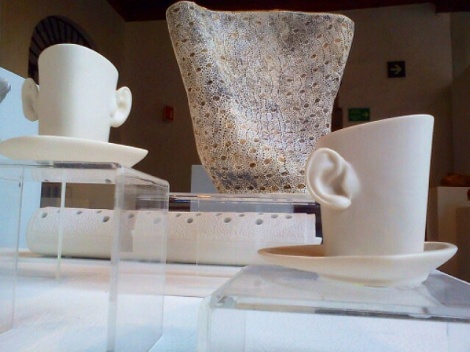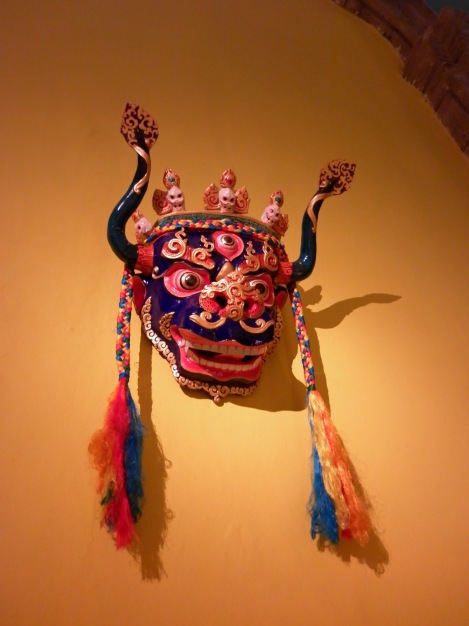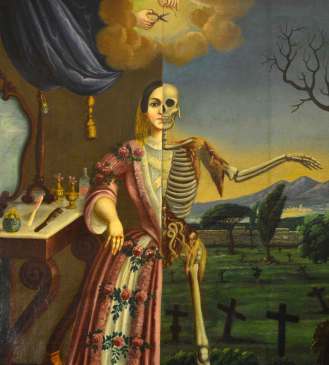Category Archives: Art & Culture
October 17, 2017 Viva Peru in Mexico

Viva Peru 2017 features the best of Peruvian art, film and cuisine at venues throughout Mexico’s capital from Oct. 22 to 27, along with several events to be held at Acapulco’s Mundo Imperial.
You can take a cooking class with accomplished Peruvian chefs at the Universidad del Claustro de Sor Juana, Liverpool department store, Festival de Sabores Peruanos at the Club de Industriales in Polanco, or restaurants Millesime, Nicos and Rosa Negra.
Audiences will get a chance to see contemporary Peruvian cinema at the Cineteca Nacional, as well as Cinemex theaters and the Universidad del Claustro de Sor Juana.
Works by Peruvian artists will go on show at La Celda Contemporanea, Sor Juana U’s contemporary art space, and Galeria Alfredo Ginocchio. The artists have also donated works for an auction to benefit victims of Mexico’s recent earthquakes. Viva Peru!
- Leave a comment
- Posted under Art & Culture, Cuisine, Events, Mexico City
November 10, 2016 Mexico Presents The China Experience
There’s never been a better time to visit China … in Mexico. As part of the Year of China-Latin America Cultural Exchange, several great exhibits are showcasing Chinese contemporary art, as well as prized folk art and ancient artifacts.
· “Masterpieces from the National Art Museum of China” at Mexico City’s San Ildefonso Museum: A charismatic statue of Confucius greets visitors at the entrance to this exhibit, which features enchanting shadow puppets, Tibetan death masks and splashy ink wash paintings.
· “The Memory of Hands: The Splendor and Color of Guizhou’s Heritage” at Mexico City’s National Museum of Cultures: Guizhou province is home to nearly 20 of China’s 55 ethnic minorities, including the Miao, famed for their rococo silver creations.
· “Memories of the Oracle Bone Inscriptions,” at Acapulco’s San Diego Fort Museum, displays the mysterious millenary origins of China’s complex writing system.
Enter El Dragon
Mexico City’s leading tour bus operator, Turibus, launched a special China-themed tourism route on Nov. 9 called “The China Experience,” which combines guided visits of “Masterpieces” and “Memory” with lunch at one of the capital’s leading Chinese restaurants, El Dragon.
Known for its Peking duck roasted in a wood-burning oven, El Dragon has put together a special tasting menu of classic favorites for you to tuck into after working up an appetite at the museums.
The China Experience is available every Wednesday starting at 10 am, with the first pick up at the Auditorio Nacional stop. Don’t miss it.
Tags: China, Chinese food, museums, tours
- Leave a comment
- Posted under Art & Culture, Cuisine, Mexico City
October 9, 2016 The Other Silk Route
Tornaviaje, or Return Voyage, a Mexico City exhibit, spotlights China’s artistic influence on the New World through trade.
The Manila Galleon, better known in Spanish as the Nao de China, regularly plied the Pacific, bringing Chinese silks, spices and lots of other goodies from the Orient to Mexico’s Pacific coast port of Acapulco. Some of it would then be shipped overland to Veracruz, on the Gulf Coast, and loaded onto ships bound for Europe.
The artistic fusion between the Far East and the New World is clear in many of the pieces on show, which were mainly made by Chinese artisans to suit European tastes, including elaborately decorated leather and wooden chests, embroidered silk shawls, carved ivory statues and ceramics.
Argh! Apparently the eyepatch wasn’t the only accessory in the pirate’s wardrobe. The scary metal mask below was reportedly worn by the infamous Dutch pirate Lorencillo, who had a long and lucrative career sacking Acapulco, Veracruz, Campeche and other Mexican ports.
Tornaviaje: The Nao de China and the Baroque in Mexico
Franz Mayer Museum
Through Oct. 30
- Leave a comment
- Posted under Art & Culture
November 21, 2013 Lending an Ear or Two at the Franz Mayer
 Say “I hear you” with this unique tea set by ceramist Oscar Vazquez Alanis, part of the 6th Biennial of Utilitarian Ceramics at Mexico City’s Franz Mayer Museum. There’s lots more on show and it’s just as amusing, including candlesticks with a plumbing theme and a lamp that lights up a forest. In all, 89 pieces by 70 artists from 12 Mexican states.
Say “I hear you” with this unique tea set by ceramist Oscar Vazquez Alanis, part of the 6th Biennial of Utilitarian Ceramics at Mexico City’s Franz Mayer Museum. There’s lots more on show and it’s just as amusing, including candlesticks with a plumbing theme and a lamp that lights up a forest. In all, 89 pieces by 70 artists from 12 Mexican states.
The museum is also hosting the 1st Biennial of Silver Design, featuring 80 creations, some award winners.
Ceramics exhibit on through Jan. 12, silver biennial, until Jan. 19.
Tags: art exhibit, ceramics, Franz Mayer Museum, silver
- Leave a comment
- Posted under Art & Culture, Mexico, Mexico City
April 6, 2012 Plumed Serpent Lands in LA
Standing tall: this six-foot pair of feet served as a column base in pre-Hispanic Mexico
Children of the Plumed Serpent, a major exhibit of pre-Hispanic artifacts, opened this week in Los Angeles. More than five centuries old, the 200 pieces on show are on loan from collections around the world, including the UK, Austria, Canada, Germany, the US and Mexico.
Among the prized works are the Nutall Codice, which may have been among the first batch of gifts Hernan Cortez shipped to Spain’s King Carlos V in the 16th century as proof of the marvels of the New World; it was borrowed from London’s British Museum. Another featured relic is also the show’s largest: a six-foot-tall (1.8 meters) column base in the shape of the feet of an Atlante, or giant; borrowed from the museum at Tula, in central Mexico.
Made of jade, turquoise, gold, seashells, pearls and other materials, these objects depict the way various cultures in Mexico, including the Maya, Toltec, Zapotec, Mixtec and Nahua, venerated the Plumed Serpent god, Quetzalcoatl. The show will travel to Dallas before arriving in Mexico towards the end of 2012.
- Children of the Plumed Serpent: The Legacy of Quetzalcoatl in Ancient Mexico
- Los Angeles County Museum of Art, now through June
- Dallas Museum of Art, July to November
- Mexico, end of 2012
Tags: archaeology, Plumed Serpent, pre-Hispanic gods, Quetzalcoatl, travel
- Leave a comment
- Posted under Archaeology, Art & Culture
March 16, 2012 Psyches in Vivid Color
Many of us are inclined to think that, with the advent of photography, the art of portrait painting has gone the way of the dodo bird. Not so, proves Swedish painter Johan Falkman, whose newly inaugurated one-man show at Mexico City’s San Ildefonso museum features more than 90 of his “psychological portraits.”
Touted for reinventing the genre through his expressionist style, Falkman says his greatest inspiration has been Mexico’s muralists, including Siqueiros, Orozco and O’Gorman. Their influence is evident in his group and individual studies in oil featuring bold strokes, highly textured surfaces and vibrant colors more typical of tropical Mexico than northern Sweden, where artists tend to use more muted shades, says exhibit curator Leticia Lopez Orozco.
Falkman’s subjects are other Swedes, from well-known doctors to actors to members of the royal family, and occasionally himself. “All of the characters I have painted in this exhibition are experts at playing their roles,” says the artist, which is one reason he selected them. Are his subjects generally happy with the end result? “Some are quite happy, but there have also been people who have been completely destroyed by it,” he admits with a laugh. “Some people have been very shocked by my depiction of them, probably because I have focused on an aspect of their personality they were not aware of.”
Falkman talks with art critic Robert C. Morgan about his career and artistic process Saturday, March 24, at 1pm (in English, with simultaneous translation). Also, art students and teachers are invited to watch the artist at work, from Tuesday, March 27, to Thursday, March 29, 10 am to 1 pm; reservations required by calling 5789 2505 or emailing pedagogicos@sanildefonso.org.mx.
- Johan Falkman, La alteridad en el espejo
- Antiguo Colegio de San Ildefonso
- Justo Sierra 16, Centro Historico
- Until July 15, 2012
Tags: expressionism, Johan Falkman, portrait painting, San Ildefonso Museum
- Leave a comment
- Posted under Art & Culture, Mexico City
February 22, 2012 New World Gave Old World New No-No’s
The discovery of the New World implied the discovery of a new world of no-no’s, a recently inaugurated exhibit of religious art shows. Transgression and Temptation in New Spain, now showing at Tepotzotlan’s National Viceregal Museum near Mexico City, illustrates the array of sins, peccadilloes and offenses that preoccupied the clergy and ruling classes in colonial-era Mexico, including some that were never an issue before, such as indulging in too much chocolate or pulque, two staples of the pre-Hispanic diet that were unknown in Europe. Both were believed to boost your energy levels, but also your libido if taken in excess, so prohibitions soon followed. This novel exhibit brings together artwork from major collections, including Mexico City’s Franz Mayer Museum and the Guadalupe Museum of Zacatecas, as well as major artists from the 17th to the 19th centuries. The 74 pieces on show, ranging from oil paintings to banned books, are grouped into four themes, including the struggle between good and evil and the road to salvation.
- El pecado y las tentaciones en la Nueva España
- Museo Nacional del Virreinato
- Plaza Hidalgo 99, Tepotzotlan, Estado de Mexico
- Until April 29, 2012
Tags: art exhibit, chocolate, Museo Nacional del Virreinato, Pulque, religious art, Tepotzotlan, travel
- Leave a comment
- Posted under Art & Culture, Mexico, Tepotzotlan
February 21, 2012 ‘Juarez 6.01’ a Tour de Farce
 On January 6, three South American passengers land at Mexico City’s Benito Juarez International Airport only to get sucked into a bureaucratic black hole generated by baffling immigration procedures and the bungling or corrupt officials handling them. That’s the premise of the play “Juarez 6.01,” a hilarious and hard-hitting political farce in which nothing is clear and no one is innocent, including the alleged offenders, each of whose motives for being in Mexico is murkier than the next.
On January 6, three South American passengers land at Mexico City’s Benito Juarez International Airport only to get sucked into a bureaucratic black hole generated by baffling immigration procedures and the bungling or corrupt officials handling them. That’s the premise of the play “Juarez 6.01,” a hilarious and hard-hitting political farce in which nothing is clear and no one is innocent, including the alleged offenders, each of whose motives for being in Mexico is murkier than the next.
“Nobody comes off looking good in this play,” says director Ernesto Alvarez, an Uruguayan who has lived in Mexico for the past 15 years. “Deceit is a constant theme throughout the story, but it also touches on the Latin American exodus, fleeing the dictatorships, searching for better opportunities abroad, the expatriate experience.”
Written by Mexican actor-director Eduardo Castañeda, “Juarez” features well-known Argentinean-born actor Juan Carlos Colombo, who has lived in Mexico since 1975 and appeared in the groundbreaking 2003 film “La Ley de Herodes” (released in the U.S. as “Herod’s Law”). The play stars Juan Carlos Medellin as an affable yet rotten-to-the-core immigration agent eager to profit from the misfortune of others.
- Juarez 6.01, El respeto al derecho me es ajeno
- Teatro Casa de la Paz, Cozumel 33, Colonia Roma
- T. 5286 5315; tdelapaz@correo.uam.mx
- Until April 15: Thursday/Friday at 8 pm, Saturday/Sunday at 6 pm
- General admission: 150 pesos
Tags: indie theater, Juarez 6.01, political farce, travel
- Leave a comment
- Posted under Art & Culture, Mexico City, Nightlife
February 17, 2012 Rachel Corrie’s Story Told in Mexico
“My Name is Rachel Corrie,” a play about the life and tragic death of the young American peace activist, will be showing at Mexico City’s Foro Shakespeare starting Monday, March 6. Corrie was crushed to death in March 2003 by an Israeli army bulldozer as she was trying to prevent the demolition of a Palestinian home in Gaza. The 23-year-old Olympia, Washington native was volunteering at the time with the International Solidarity Movement.
Derived entirely from Corrie’s diary entries and email letters, the play was written by English actor-director Alan Rickman and journalist Katharine Viner. It premiered at London’s Royal Court Theater in 2005, winning awards for Best Director, Best New Play and Best Solo Performance. It has since been staged by a variety of theater companies around the world. This Spanish-language production features a brilliant performance by Maria Ines Pintado under the direction of Edgar Alvarez Estrada.
The play is a gripping personal account of life in the occupied territories and a fascinating portrayal of a college student so motivated and aware of the world around her that she is compelled to respond to a conflict that brings a measure of violence into all of our lives.
- Me llamo Rachel Corrie
- Foro Shakespeare, Zamora No. 7, Condesa
- Mondays at 8:30 pm from March 6 to 26
Tags: Foro Shakespeare, indie theater, play, Rachel Corrie
- Leave a comment
- Posted under Art & Culture, Mexico City







